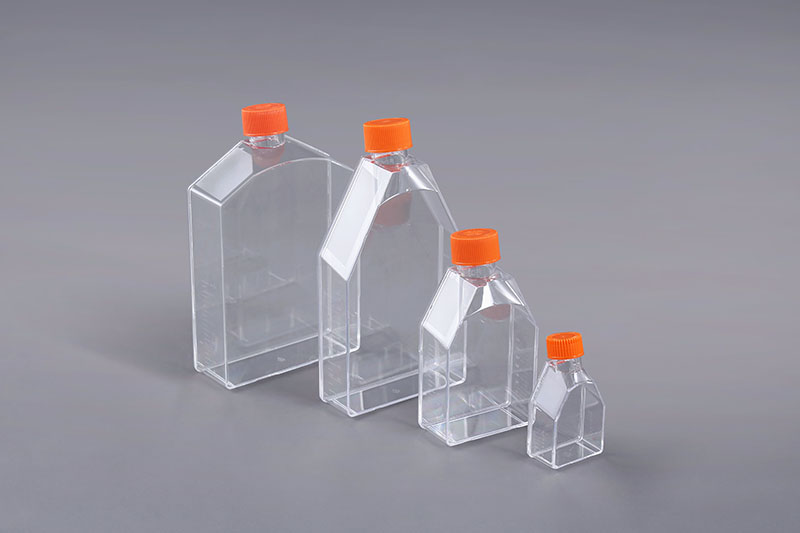представляют собой расходные материалы для клеток, подходящие для средних культур клеток и тканей в лаборатории. Общие характеристики включают 25 см², 75 см², 175 см², 225 см² и т. д. и широко используются в технологических центрах клеточных культур. и удобен для наблюдения под микроскопом. В соответствии с различными типами культивируемых клеток они делятся на гидрофильные поверхности TC и гидрофобные поверхности без TC. Есть два типа колпачков: герметичный колпачок и вентиляционный колпачок. В воздухопроницаемой крышке есть гидрофобная фильтрующая мембрана 0,2 мкм для обеспечения стерильного газообмена. Для снижения риска загрязнения в основном используется для открытого выращивания. Уплотнительные крышки часто используются для герметичного культивирования, чтобы обеспечить герметичность, а также могут использоваться для открытого культивирования, когда крышка бутылки отвинчена. решение. Горлышко бутылки выполнено с матовым покрытием, что удобно для маркировки, чтобы различать бутылки для разных экспериментальных целей. Рельефная линия на задней стенке облегчает штабелирование культуральных флаконов и предотвращает их соскальзывание. Конструкция с широким горлышком позволяет пипетке и скребку для клеток входить в бутылку под любым углом. можно использовать для культивирования клеток Vero, клеток HEK 293, клеток CAR-T, клеток MRC5, CEF и других прилипшие клетки. Его также можно использовать для статической культуры суспензионных клеток, таких как клетки CHO, клетки насекомых, клетки BHK21 и клетки MDCK. Колбы для культивирования клеток
The cell culture flasks are made of transparent polystyrene raw material, which has excellent optical properties and is convenient for microscope observation. According to the different types of cultured cells, it is divided into TC hydrophilic surface and non-TC hydrophobic surface. There are two types of caps: sealing cap and vent cap. There is a 0.2μm hydrophobic filter membrane in the breathable cap to provide sterile gas exchange. To reduce the risk of pollution, it is mainly used for open cultivation. Sealing caps are often used for airtight culture to ensure airtightness, and can also be used for open culture when the bottle cap is unscrewed.
The side of the cell culture flasks have a clear scale, which can improve the accuracy of the culture solution. The bottleneck part is designed with frosted, which is convenient for marking to distinguish the bottles for different experimental purposes. The ridgeline design on the back makes it easier to stack the culture bottles and prevent them from slipping off. The wide neck design allows the pipette and cell scraper to enter the bottle at any angle.
The cell culture flasks can be used for the culture of Vero cells, HEK 293 cells, CAR-T cells, MRC5, CEF cells and other adherent cells, It can also be used for static culture of suspension cells such as CHO cells, insect cells, BHK21 cells and MDCK cells.
The FAI climbed 5.9 percent year-on-year in the first 11 months of 2018, quickening from the 5.7-percent growth in Jan-Oct, the National Bureau of Statistics (NBS) said Friday in an online statement.
The key indicator of investment, dubbed a major growth driver, hit the bottom in August and has since started to rebound steadily.
In the face of emerging economic challenges home and abroad, China has stepped up efforts to stabilize investment, in particular rolling out measures to motivate private investors and channel funds into infrastructure.
Friday's data showed private investment, accounting for more than 60 percent of the total FAI, expanded by a brisk 8.7 percent.
NBS spokesperson Mao Shengyong said funds into weak economic links registered rapid increases as investment in environmental protection and agriculture jumped 42 percent and 12.5 percent respectively, much faster than the average.
In breakdown, investment in high-tech and equipment manufacturing remained vigorous with 16.1-percent and 11.6-percent increases respectively in the first 11 months. Infrastructure investment gained 3.7 percent, staying flat. Investment in property development rose 9.7 percent, also unchanged.
 English
English



















































